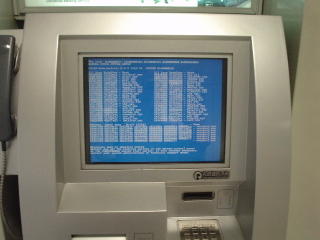OS: Fedora Core 2
3Com 3CRWE154G72:
http://www.3com.com/products/en_US/detail.jsp?tab=features&
pathtype=purchase&sku=3CRWE154G72
bought it in Nova/Taipei NT:1600
i also bought Bufallo WLI-PCM-L11GP AirStation PCI Adapter Card:
http://www.buffalotech.com/products/product-detail.php?productid=
68&categoryid=9
because there is no pcmcia slot on my notebook (iBook), i have to
use this card on my pc in order to use 3Com pcmcia wireless card.
Bufallo WLI-PCM-L11GP works perfect on FC2.
NT:900
Reference document:
http://mysite.verizon.net/winterz/doc/prism54_fc2.txt
install steps:
1. mkdir -p /usr/lib/hotplug/firmware
2. cd /usr/lib/hotplug/firmware
3. mount your driver CD of 3Com
4. copy 3Com firmware in CD to /usr/lib/hotplug/firmware and
rename to isl3890.
for example:
[root@localhost firmware]# ls /usr/lib/hotplug/firmware
isl3890
5. plug 3Com 3CRWE154G72 into pcmcia slot
6. check if FC2 detect your 3Com card:
[root@localhost root]# iwconfig
lo no wireless extensions.
eth0 no wireless extensions.
eth1 NOT READY! ESSID:off/any
Mode:Managed Channel:6 Access Point: 00:00:00:00:00:00
Tx-Power=31 dBm Sensitivity=0/200
Retry min limit:0 RTS thr=0 B Fragment thr=0 B
Encryption key:off
Link Quality:0 Signal level:0 Noise level:0
Rx invalid nwid:0 Rx invalid crypt:0 Rx invalid frag:0
Tx excessive retries:0 Invalid misc:0 Missed beacon:0
sit0 no wireless extensions.
7. bring up eth1:
[root@localhost root]# ifconfig eth1 up
8. scan your AP:
[root@localhost root]# iwlist eth1 scanning
eth1 Scan completed :
Cell 01 - Address: 00:E0:98:4C:05:6E
ESSID:"wyw"
Mode:Master
Encryption key:off
Frequency:2.462GHz
Quality:102/0 Signal level:-46 dBm Noise level:-148 dBm
9. create a new file named "ifcfg-eth1" in /etc/sysconfig/network-scripts:
DEVICE=eth1
BOOTPROTO=dhcp
ONBOOT=yes
MODE=Managed
ESSID=wyw
10. use "dhclient" command to get ip from AP:
[root@localhost root]# dhclient eth1
Internet Software Consortium DHCP Client V3.0.1rc12
Copyright 1995-2002 Internet Software Consortium.
All rights reserved.
For info, please visit http://www.isc.org/products/DHCP
sit0: unknown hardware address type 776
sit0: unknown hardware address type 776
Listening on LPF/eth1/00:0d:54:a1:8f:b5
Sending on LPF/eth1/00:0d:54:a1:8f:b5
Sending on Socket/fallback
DHCPREQUEST on eth1 to 255.255.255.255 port 67
DHCPACK from 192.168.1.254
SIOCADDRT: File exists
bound to 192.168.1.88 -- renewal in 121862 seconds.
11. now your 3Com 3CWRE154G72 pcmcia wireless card works perfectly:
[root@localhost root]# ifconfig eth1
eth1 Link encap:Ethernet HWaddr 00:0D:54:A1:8F:B5
inet addr:192.168.1.88 Bcast:192.168.1.255 Mask:255.255.255.0
inet6 addr: fe80::20d:54ff:fea1:8fb5/64 Scope:Link
UP BROADCAST RUNNING MULTICAST MTU:1500 Metric:1
RX packets:20 errors:0 dropped:0 overruns:0 frame:0
TX packets:6 errors:0 dropped:0 overruns:0 carrier:0
collisions:0 txqueuelen:1000
RX bytes:2480 (2.4 Kb) TX bytes:720 (720.0 b)
Interrupt:11
[root@localhost root]# iwconfig eth1
eth1 IEEE 802.11b/g ESSID:"wyw"
Mode:Managed Channel:11 Access Point: 00:E0:98:4C:05:6E
Bit Rate:11Mb/s Tx-Power=31 dBm Sensitivity=20/200
Retry min limit:8 RTS thr:2347 B Fragment thr:2346 B
Encryption key:off
Link Quality:0 Signal level:0 Noise level:0
Rx invalid nwid:0 Rx invalid crypt:0 Rx invalid frag:0
Tx excessive retries:0 Invalid misc:0 Missed beacon:0
****************
there is also a good web site & forum that talk about prism chipset:
http://www.prism54.org/
http://www.prism54.org/forums/
